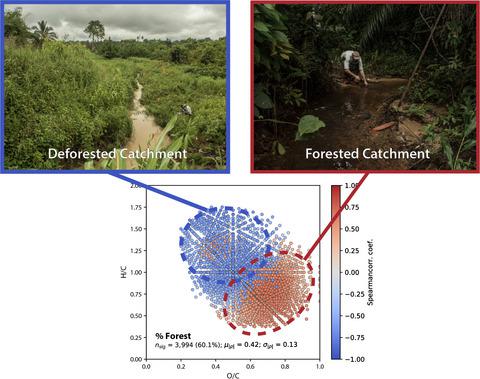当前位置:
X-MOL 学术
›
Glob. Change Biol.
›
论文详情
Our official English website, www.x-mol.net, welcomes your
feedback! (Note: you will need to create a separate account there.)
Land-use controls on carbon biogeochemistry in lowland streams of the Congo Basin.
Global Change Biology ( IF 10.8 ) Pub Date : 2019-10-30 , DOI: 10.1111/gcb.14889 Travis W Drake 1, 2 , David C Podgorski 3 , Bienvenu Dinga 4 , Jeffrey P Chanton 1 , Johan Six 2 , Robert G M Spencer 1
Global Change Biology ( IF 10.8 ) Pub Date : 2019-10-30 , DOI: 10.1111/gcb.14889 Travis W Drake 1, 2 , David C Podgorski 3 , Bienvenu Dinga 4 , Jeffrey P Chanton 1 , Johan Six 2 , Robert G M Spencer 1
Affiliation

|
The flux and composition of carbon (C) from land to rivers represents a critical component of the global C cycle as well as a powerful integrator of landscape-level processes. In the Congo Basin, an expansive network of streams and rivers transport and cycle terrigenous C sourced from the largest swathe of pristine tropical forest on Earth. Increasing rates of deforestation and conversion to agriculture in the Basin are altering the current regime of terrestrial-to-aquatic biogeochemical cycling of C. To investigate the role of deforestation on dissolved organic and inorganic C (DOC and DIC, respectively) biogeochemistry in the Congo Basin, six lowland streams that drain catchments of varying forest proportion (12%-77%) were sampled monthly for 1 year. Annual mean concentrations of DOC exhibited an asymptotic response to forest loss, while DIC concentrations increased continuously with forest loss. The isotopic signature of DIC became significantly more enriched with deforestation, indicating a shift in source and processes controlling DIC production. The composition of dissolved organic matter (DOM), as revealed by ultra-high-resolution mass spectrometry, indicated that deforested catchments export relatively more aliphatic and heteroatomic DOM sourced from microbial biomass in soils. The DOM compositional results imply that DOM from the deforested sites is more biolabile than DOM from the forest, consistent with the corresponding elevated stream CO2 concentrations. In short, forest loss results in significant and comprehensive shifts in the C biogeochemistry of the associated streams. It is apparent that land-use conversion has the potential to dramatically affect the C cycle in the Congo Basin by reducing the downstream flux of stable, vascular-plant derived DOC while increasing the transfer of biolabile soil C to the atmosphere.
中文翻译:

刚果盆地低地河流碳生物地球化学的土地利用控制。
从陆地到河流的碳(C)的通量和组成是全球碳循环的重要组成部分,也是景观过程的有力整合者。在刚果盆地,广阔的河流和河流网络运输和循环了陆源碳,其起源于地球上最大的原始热带森林。流域森林砍伐率和向农业的转化率不断提高,改变了目前陆地从陆地到水生生物地球化学循环的格局。研究森林砍伐对刚果溶解性有机碳和无机碳(分别为DOC和DIC)生物地球化学的作用盆地中,有六个低地小溪每月抽水一次,抽水量各不相同的森林比例(12%-77%),为期一年。DOC的年平均浓度表现出对森林流失的渐进响应,DIC浓度随着森林的流失而持续增加。DIC的同位素特征因森林砍伐而变得更加丰富,表明控制DIC生产的来源和过程发生了变化。超高分辨率质谱显示,溶解有机物(DOM)的组成表明,森林砍伐的集水区出口相对较多的源自土壤微生物量的脂肪族和杂原子DOM。DOM的组成结果表明,来自森林砍伐地点的DOM比来自森林的DOM具有更高的生物不稳定性,这与相应的溪流CO2浓度升高相一致。简而言之,森林流失会导致相关溪流的C生物地球化学发生重大而全面的转变。
更新日期:2020-01-13
中文翻译:

刚果盆地低地河流碳生物地球化学的土地利用控制。
从陆地到河流的碳(C)的通量和组成是全球碳循环的重要组成部分,也是景观过程的有力整合者。在刚果盆地,广阔的河流和河流网络运输和循环了陆源碳,其起源于地球上最大的原始热带森林。流域森林砍伐率和向农业的转化率不断提高,改变了目前陆地从陆地到水生生物地球化学循环的格局。研究森林砍伐对刚果溶解性有机碳和无机碳(分别为DOC和DIC)生物地球化学的作用盆地中,有六个低地小溪每月抽水一次,抽水量各不相同的森林比例(12%-77%),为期一年。DOC的年平均浓度表现出对森林流失的渐进响应,DIC浓度随着森林的流失而持续增加。DIC的同位素特征因森林砍伐而变得更加丰富,表明控制DIC生产的来源和过程发生了变化。超高分辨率质谱显示,溶解有机物(DOM)的组成表明,森林砍伐的集水区出口相对较多的源自土壤微生物量的脂肪族和杂原子DOM。DOM的组成结果表明,来自森林砍伐地点的DOM比来自森林的DOM具有更高的生物不稳定性,这与相应的溪流CO2浓度升高相一致。简而言之,森林流失会导致相关溪流的C生物地球化学发生重大而全面的转变。











































 京公网安备 11010802027423号
京公网安备 11010802027423号